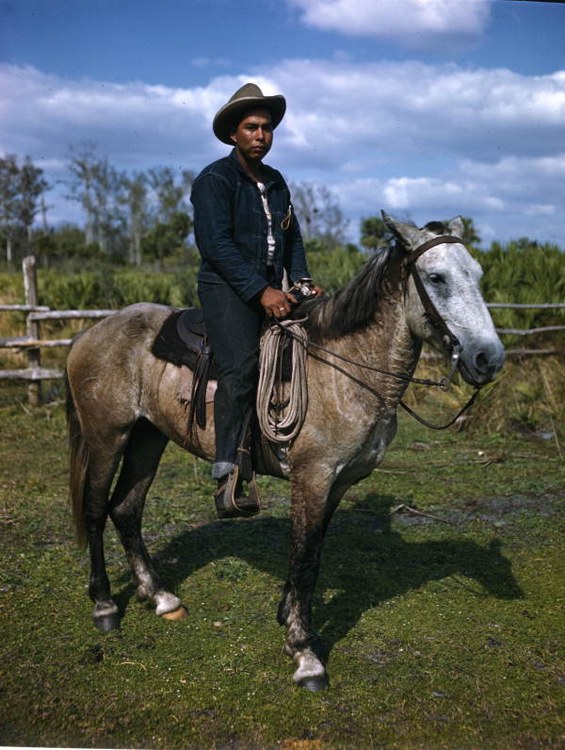Oldest Ranchers In America Who Drove Out The Spanish Mark 500 Years Of ‘Cowkeeping’ In Florida

The oldest ranchers in America are actually the native Floridan Seminole tribe, who carry on that legacy today by receiving top dollar for their cattle.
This decade marks the 500th anniversary of the start of Seminole ranching, which began back when their ancestors captured 20 head of cattle from the landing party of a famous Spaniard looking to settle Florida for the crown in Madrid.
There are hair-razing, tear-jerking, page-turning stories of the lives and times of Native American tribes across the country, but one nation that maybe doesn’t get the billing it deserves are the Seminoles.
These Everglades dwellers inherited a cultural tradition 5,000 years old, and wrote a rich history of both resisting colonialism and living off a different kind of land to the Indians on the plains. The course of their story was forever altered when in 1521, Juan Ponce de Leon, a Spanish conquistador, landed in Florida with a mandate to set up a Spanish colony on the Peninsula.
The Seminoles’ ancestors, known today as the Calusa people, violently resisted the settlement attempt and drove the Spaniards off. Ponce de Leon died of his injuries, the colonization was abandoned, and the reward for the Calusa were 20 head of Old World Andalusian cattle, which, according to a story in Successful Farming, thrived in the Floridian climate.
“They immediately took to raising them and the cattle did really well,” said Alex Johns, a Seminole cattleman whose ancestry goes back to those early times. “It was just great cattle country, with lush grass and warm temperatures. Those Native Americans were my ancestors, and we’ve been raising cattle here ever since.”
Bison lived in Florida before Ponce de Leon’s arrival, but the natives had apparently hunted them almost to extirpation. The Calusa celebrated the cattle as a return of the bovid to their lands. These would develop to become the famous Florida ‘Cracker’ cattle, a beautiful heritage breed that the Calusa would have reared, and which remain today the official state heritage cattle breed.
More than 100 years after they first got their hands on the Spanish herd, a legendary Seminole chief, who came to be known as “Cowkeeper,” amassed a herd of some 1,000 cattle in central Florida. One story goes that Cowkeeper’s herds fed both armies during the American Revolutionary War, and whatever the truth of that story is, many Seminole ranchers today refer to themselves collectively as “Cowkeepers.”
MORE FLORIDA HISTORY: Two Scholars Reveal Incredible Insights Into Floridian Natives Through Long-Lost Language Translations
Wars between the tribe and the fledging central government in Washington, DC, eventually culminated in the the infamous Trail of Tears where thousands of natives from across the country were forced to emigrate to Oklahoma, the Seminoles was one tribe which managed to hold out.
Led by the medicine man known as Abiaka, or Sam Jones, around 500 refused to leave Florida and isolated themselves in the Everglades, hidden, along with their herds, in the depths of the swamps until shifting opinions and priorities led to an end of the persecution from that earlier era.

Starting in the 20th century, the descendants of those 500 hold outs began a counterattack of sorts, reclaiming through legal challenges around 80,000 acres of land in Florida, and obtaining recognition as a tribe in 1957.
NATIVE RANCHERS IN THE US: Bison Ranchers Return Thousands of Animals to Native Lands and Witness Total Rejuvenation of Ecosystem
All the while, the tribe maintained their tradition of cattle herding, which was already hundreds of years old by that time. In the 1920s, the Seminole Tribes of Florida co-op was founded for the collective benefit of the cattle ranchers in Florida.
Today, that co-op includes 68 families, who ranch 10,000 head of cattle—over half of whom are owned by women.
“We’re a matriarchal society; we go by our mother’s ancestry,” Johns told Successful Farming. “Part of that is because of all the wars we fought. The men didn’t live very long.”
MORE CATTLE STORIES: Herd of Bulls Headed to the Highlands to Recreate Effect of Ancient Auroch Oxen on Scottish Soil
Johns is the executive director of the entire agricultural side of the Seminole Tribe of Florida, has 150 cows in the co-op herd, and another 350 in a herd on land leased from the government.
While the original Andalusian cattle the tribe captured were bred for meat and milk production, today the Seminoles receive premium prices for the breeding of part Brahma part Angus cattle for genetics, both focused on growth and heat tolerance, the latter of the two emerging as a critical consideration for cattle ranchers in various parts of the world.






Please be good and do not spam. Thank you.